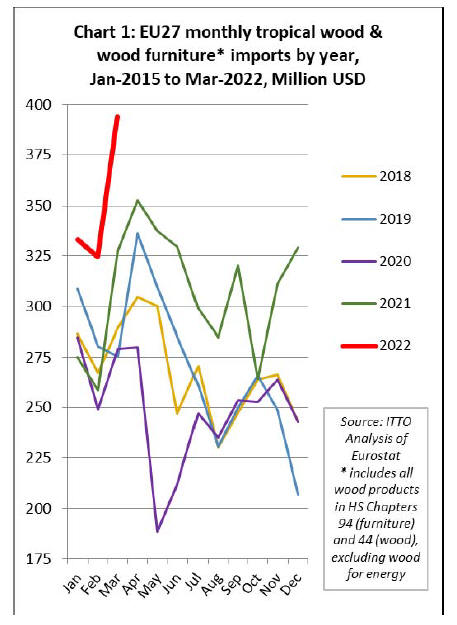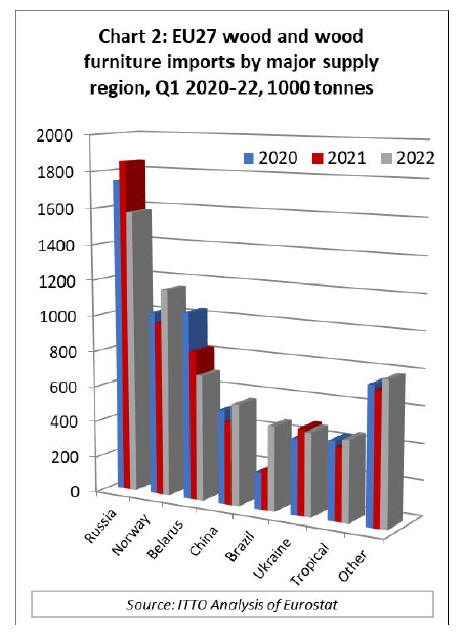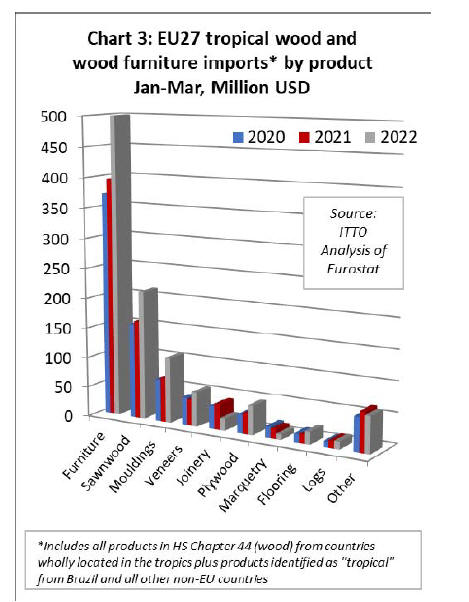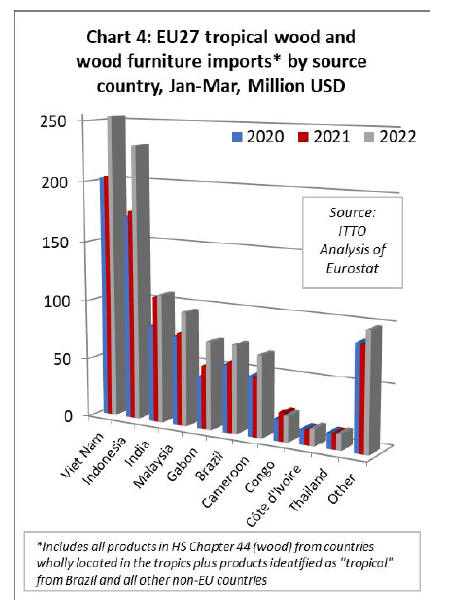|
Report from
Europe
EU27 tropical wood import value at highest level
for a
decade
In the first three months of this year, the value of EU
imports of tropical wood and wooden furniture was at a
level not seen for over a decade.
Import value was US$1.05 billion in the first quarter, a
gain of 22% compared to the same period last year. It was
also 16% up on the last quarter in 2021 when trade was
already at a decadal high for that period of the year (Chart
1).

A large part of the gain in tropical wood import value in
the first quarter this year reflected a rise in CIF prices,
driven both by continuing high freight rates and severe
shortages of wood and other materials due to logistical
challenges during the global pandemic. In quantity terms,
EU imports of tropical wood and wooden furniture
products in the first quarter this year were, at 459,000
tonnes, up only 10% compared to the same period in 2021
and slightly below the pre-pandemic level of 479,000
tonnes in the first quarter of 2020.
The Drewry World Container Index shows that global
rates for a 40 foot container, after peaking at US$10400 in
the middle of September 2021 compared to US$2000 in
the same month in 2020, were still in excess of US$9000
for most of the first quarter this year.
The index began to fall from mid-March this year but
remains at an historically high level of US$7600 in May.
Nevertheless, a robust rebound in EU economic activity
following the COVID downturn did play a role to
underpin stronger trade in tropical wood products during
the first quarter this year. Rising activity in key sectors
such as furniture and construction, particularly in private
sector renovation, maintenance, and improvement (RMI),
coincided with severe shortfalls in the supply of tropical
wood alternatives.
These shortfalls have become even more pronounced since
Russia's invasion of Ukraine on 24 February greatly
curtailed availability from Russia, Belarus and Ukraine.
Together these three countries accounted for over 50% of
all wood fibre imported into the EU for outside the bloc
last year.
The curtailment of supplies from these countries is
opening up new opportunities in the EU market for some
tropical wood products, notably plywood and decking for
which Russian birch and larch products have been
important substitutes.
The first quarter import data doesn't reveal any increase in
share for tropical wood in the EU market, unsurprising as
the full impact of the war in Ukraine on wood supply in
the EU had yet to be felt in that period. However, EU
imports from Russia and Belarus did begin to decline
during this period and early beneficiaries of the opening
supply gap appear to have been Norway, China and, most
notably, Brazil (non-tropical products only) (Chart 2).

Meanwhile the war in Ukraine is having a severely
detrimental effect on the wider European economy. Before
the invasion, the EU economy was well positioned for
robust recovery as COVID restrictions have been eased
and as funds from the €723.8 billion Recovery and
Resilience Facility are now being rolled out across the EU
Member States.
But now growth projections are being severely cut back in
the face of rapidly rising energy costs as EU countries are
under considerable pressure to reduce dependence on
Russian gas and oil. Rising energy costs, combined with
the direct impact of the war and trade sanctions on
availability of agricultural and other essential
commodities, is driving inflation in the EU to historically
high levels.
The inflation shock has been made worse by the impact on
supply chains from Covid lockdowns in China.
To dampen inflation, European central banks are now
under pressure to raise interest rates. But this would bring
borrowing costs to levels unseen since the recession
caused by the 2008 financial crisis and would likely
undermine fragile consumer confidence and reduce
business investment. So while EU demand for wood
products was high at the start of this year, it may tail off
later in the year.
Strong growth in EU27 imports of wooden furniture,
sawnwood and decking
The increase in the value of EU27 imports from tropical
countries in the first quarter this year was concentrated in
wooden furniture products, sawnwood and
mouldings/decking (Chart 3).
For wood furniture, import value of US$500m during the
three month period was 26% more than the same period
last year. For tropical sawnwood, import value of
US$214m was 31% up on the same period last year.
Import value of tropical mouldings/decking was US$108m
in the first quarter this year, a gain of 47% compared to the
same period in 2021.
There were also significant gains, but from a smaller base,
in the value of EU imports of tropical veneer (+32% to
US$57m), plywood (+41% to US$48m), and flooring
(+41% to US$20m) in the first quarter this year. Import
value of tropical logs was US$13m in the first quarter this
year, just 6% more than the same period last year.
In contrast, EU import value of other tropical joinery
products (mainly doors and laminated window scantlings
and kitchen tops) declined by 52% to just US$21m in the
first quarter of this year.

In terms of source countries, EU27 import value of wood
and wooden furniture in the first quarter this year was up
significantly compared to the same period last year from
Viet Nam (+24% to US$253m), Indonesia (+31% to
US$230m), Malaysia (+22% to US$96m), Gabon (+39%
to US$74m), Brazil (+25% to US$74m), Cameroon
(+38% to US$68m), and Cote d'Ivoire (+18% to
US$14m).
However, import value from India increased only 2% to
US$108m while import value from the Republic of Congo
declined 9% to US$21m (Chart 4).

In terms of destinations, EU27 import value of tropical
wood and wooden furniture in the first quarter this year
was up significantly compared to the same period in 2021
in France (+25% to US$212m), Germany (+17% to
US$173m), Belgium (+39% to US$168m), Italy (+50% to
US$86m), Spain (+28% to US$55m), and Ireland (+42%
to US$24m).
Import value was little changed compared to last year in
Netherlands (US$175m) and Denmark (US$45m). Import
value was down 11% to US$21 million in Poland (Chart
5).

EU wood sanctions against Russia and Belarus
Since March 2014 the EU has progressively imposed
sanctions against Russia, initially in response to Russia's
annexation of Crimea and Sevastopol and deliberate
destabilisation of Ukraine. On 23 February 2022, the EU
expanded the sanctions in response to the recognition of
the non-government controlled areas of the Donetsk and
Luhansk oblasts of Ukraine and the ordering of Russian
armed forces into those areas.
After 24 February 2022, in response to Russia¡¯s invasion
of Ukraine, the EU massively expanded the sanctions. It
added a significant number of persons and entities to the
sanctions list and adopted unprecedented measures with
the aim of significantly weakening Russia's economic
base, depriving it of critical technologies and markets, and
significantly curtailing its ability to wage war.
EU economic sanctions now directly target exchanges
with Russia in a wide range of economic sectors. The
wood sector is specifically identified as subject to EU
sanction so that all EU wood product imports from Russia
into the EU are now banned according to EU legislation.
In addition, in response to Belarus role in support of
Russia's invasion of Ukraine, the EU has banned all trade
in wood products with Belarus, and all transhipment of
Belarus wood products to other countries via the EU.
Other measures indirectly affect the wider trade in timber,
including a ban on access of all Russian ships to EU ports
and a ban on the entry of Russian and Belarusian road
transporters into the EU.
Overall the measures are expected to add to volatility of
wood markets in the EU and contribute to a significant
wood supply deficit as around 45% of wood imports, by
tonnage, into the EU from outside the bloc were formerly
derived from Russia and Belarus. Certification systems are
also affected as timber sourced from Russia and Belarus is
considered as "conflict timber" and therefore cannot be
FSC or PEFC certified.
More details EU sanctions against Russia and Belarus are
available at:
https://ec.europa.eu/info/business-economy-euro/banking-andfinance/international-relations/restrictive-measuressanctions/sanctions-adopted-following-russias-militaryaggression-against-ukraine_en
Reduction in EU growth forecast due to conflict in
Ukraine
According to the EU's Spring Forecast published on 16
May, the outlook for the EU economy before Russia's
invasion of Ukraine on 24 February was for a prolonged
and robust expansion. But the war in Ukraine has posed
new challenges just as the EU had recovered from the
economic impacts of the pandemic.
By exerting further upward pressures on commodity
prices, causing renewed supply disruption and increasing
uncertainty, the war is exacerbating pre-existing
headwinds to growth, which were previously expected to
subside. This has led the European Commission (EC) to
revise the EU's growth outlook downwards, and the
forecast for inflation upwards.
Real GDP growth in both the EU and the euro area is now
projected by the EC at 2.7% in 2022 and 2.3% in 2023,
down from 4.0% and 2.8%, respectively, in the Winter
2022 interim Forecast. Continued growth is due to the
combined effect of post-lockdown re-openings of service
industries and the strong policy action taken to support
growth during the pandemic.
A strong and still improving labour market, lower
accumulation of savings and fiscal measures to offset
rising energy prices are set to support private
consumption. Investment is set to benefit from the full
deployment of the EU's Recovery and Resilience Facility
and the implementation of the accompanying reform
agenda.
The main hit to the global and EU economies due to the
war in Ukraine comes through energy commodity prices.
Although they had already increased substantially before
the war, from the low levels recorded during the
pandemic, uncertainty about supply chains has pressured
prices upwards, while increasing their volatility. This is
true for food and other basic goods and services, with
households' purchasing power declining.
War-induced logistics and supply chain disruptions, as
well as rising input costs for a broad array of raw
materials, add to the disturbances in global trade caused by
the drastic COVID-19 containment measures still applied
in parts of China, weighing on production.
Together these factors have led to a sharp rise in inflation
in the EU. Inflation is expected to increase from 2.9% in
2021 to 6.8% in 2022 and fall back to 3.2% in 2023.
More encouragingly, the EU labour market is entering the
new crisis on a strong footing. In 2021, more than 5.2
million jobs were created in the EU economy, which
attracted nearly 3.5 million more people into the labour
market. In addition, the number of unemployed decreased
by nearly 1.8 million people.
Unemployment rates at the end of 2021 fell below
previous record lows. Labour market conditions are
expected to improve further with unemployment rates
forecast to decline to 6.7% this year and 6.5% in 2023.
Despite the costs of measures to mitigate the impact of
high energy prices and to support people fleeing Ukraine,
the aggregate government deficit in the EU is set to
decline further in 2022 and 2023 as temporary COVID-19
support measures continue to be withdrawn. From 4.7% of
GDP in 2021, the deficit in the EU is forecast to fall to
3.6% of GDP in 2022 and 2.5% in 2023 (3.7% and 2.5%
in the euro area).
The EC notes that risks to the forecast for economic
activity and inflation are heavily dependent on the
evolution of the war, and especially on its impact on
energy markets. For example, an outright cut in EU gas
supply from Russia ¨C which is possible given rising
tensions ¨C would lead to GDP growth rates around 2.5 and
1 percentage points below the baseline forecast in 2022
and 2023.
On top of such potential disruptions in energy supply,
worse than expected problems in supply chains and further
increases in non-energy commodity prices, especially
food, could lead to additional downward pressures on
growth, and upward pressures on prices. COVID-19 also
remains a risk factor.
Sharp fall in EU construction orders in April
Mounting economic uncertainty in the EU since the start
of the Ukraine war is feeding through into a slowdown in
construction sector growth. This is evident from the latest
S&P Global Eurozone Construction Purchasing Managers
Index (PMI) issued 5 May.
S&P Global note that "The upturn in the eurozone
construction sector may have extended to a seventh month
in April, but the rate of growth eased considerably to reach
the slowest in this sequence. The slowdown in activity
came amid the sharpest reduction in new order inflows
since February 2021 as supply shortages and headwinds
from the war in Ukraine weighed increasingly on
confidence and potential tenders".
S&P Global also highlight that construction firms
continued to report widespread shortages of raw materials
across the bloc and beyond in April, which placed
sustained strain on supply chains and cost burdens.
As a result the rate of input price inflation accelerated
from March to the second-highest in the survey history.
Increased headwinds from supply chains and the impact of
the war dampened confidence, with firms signalling the
greatest degree of pessimism since November 2020.
At the national level, S&P Global report that Italian firms
indicated a solid rise in activity that was the slowest for six
months, while French companies saw a renewed rise.
However constructors in Germany reported the sharpest
fall in activity since August 2021.
Tropical timbers added to EU Endangered Species
Regulation
In January 2022, the European Commission listed new
species in Annex D of the EU Regulation of 16 December
2021 amending the Regulation on the protection of species
of wild fauna and flora by regulating trade therein and the
EC Regulation.
Annex D: includes species which are not listed in CITES
but whose import volumes the EU considers justify
monitoring. Species listed in EU Annex D include:
Okoum¨¦: Aucoumea klaineana
Ipe: Handroanthus spp
Sapelli: Entandrophragma cylindricum
Moabi: Baillonella toxisperma :
All imports of Annex D species must be covered by an
Import Notification. Blank import notification forms for
specimens of species listed in Annex D are available from
the CITES Management Authority of the EU Member
State of destination.
The EU importer is responsible for completing the form
and presenting the notification to the Customs service at
the first point of introduction into the EU. After
verification of the documents presented, the customs
service completes and endorses the import notification
sheets.
|